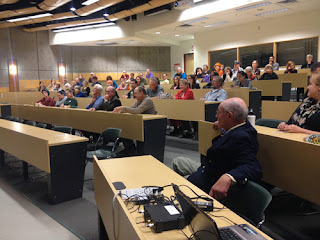Predators occupy quite a
space in the human psyche. Humans have been “at war” with many of them since
the earliest days of livestock domestication. While the lion occupies the
imagination people everywhere, in North America no predator is more symbolic of
this war than the wolf. Our attitudes are ever fluctuating. There are websites
and social media gatherings where the full range, from “kill them all” to “full
protection” is on display.
These two very opposite views
about them were written about another pack-hunting wild canid, in this case the
African wild dog.
In 1914, one R. Maugham wrote: "Let us consider for a
moment that abomination - that blot upon the many interesting wild things - the
murderous Wild Dog. It will be an excellent day for African game and its
preservation when means can be devised for its complete extermination."
These words could easily be
used by the anti-wolf crowd in 2013.
 |
| Dr. Kobus Raath's ;picture of wilfe dogs in Kruger N P |
The other view, also resonates for many folks. They
were written in 1997 by David
MacDonald of Oxford University. “To nominate one sight as the most
beautiful I have seen might, in a world filled with natural marvels, be
considered disingenuous. Yet, of images jostling for supremacy in my memory, it
is hard to better the bounding forms of African wild dogs, skiffing like
golden pebbles across a sea of sunburnt grass at dusk.”
A group of concerned, but
balanced individuals has recently launched a website that examines some of the
many issues . They are particularly concerned about some of
the aspects of wolf management in Alberta, and by extension elsewhere in North
America.
 |
| Myrna Pearman's beautiful picture is one of the site's headers. |
As you skull around the site you will find links and articles by people who have had an enormous amount of experience with wolf management and are concerned with the way that things are developing.
Among them are Dr. Lu Carbyn, noted world wolf authority, who has expressed deep concerns and published an article critical of the province's wolf bounty program in the Journal of the Canadian Society of Environmental Biologists.
There are very obvious animal
welfare issues at hand. Dr. Jose Diaz
of the University of Calgary, who is
an accredited specialist in animal neurology examines the effects of snares in
his piece in the Gallery of Shame http://www.wolfmatters.org/articles.html -
Dwight Rodtka, who worked
with wolves for his entire career has contributed pieces to the site.
Dwight expresses deep concern not only about the Alberta government’s whole wolf program
but very specifically about snares, which he states in his piece The Truth About Snares are “archaic and torturous devices which should have been banned
years ago.”
 |
| Dr. Garcia examines the damage. The lion died as he arrived on scene. |
I have seen the aftermath of
snaring in several African countries but perhaps the most dramatic one was of a
dying lion in Tanzania’s Serengeti. The animal’s end was witnessed by friend
and former student Dr. Patrick Garcia.
Gruesome fits the scene well.
It is much more than just
snares and traps. My own contribution to the debate is also from an animal
welfare perspective. It is about poisoning
and comes straight from things I witnessed in Kenya 45 years ago.
You can read the piece at the
link above, but if your time is short here is my opening:
The debate, seldom polite,
often vigorous, about the wolf and its presence among us often becomes a “to
poison or not to poison” matter. The subject waxes and wanes, but today, in
parts of Alberta and British Columbia, indeed in many parts of North America,
it is indeed the question, and strychnine is the apparent sling and arrow.
I suspect that most people who espouse the poisoning route have never seen the effects of this deadly substance on any animal.
Unfortunately I have.
I suspect that most people who espouse the poisoning route have never seen the effects of this deadly substance on any animal.
Unfortunately I have.
 In the body of the article I
quoted wolf biologist Bob Hayes about the “by-catch” effects of strychnine.
They are horrific. Bob worked in Canada’s Yukon for many years on wolf control.
His 2010 book Wolves of the Yukon is
a very worthwhile read.
In the body of the article I
quoted wolf biologist Bob Hayes about the “by-catch” effects of strychnine.
They are horrific. Bob worked in Canada’s Yukon for many years on wolf control.
His 2010 book Wolves of the Yukon is
a very worthwhile read.
I closed with this:
If the rancher who cannot prevent wolf attacks by
other methods (which do exist) and has to use this deadly substance to “take
arms against a sea of troubles” caused by livestock predation then we are in a
sorry state.
Strychnine poisoning is very definitely an animal
welfare issue. Its use is inhumane.

I am by no means alone in this view and I hope that other veterinarians feel the same. If they do, rather than write to me I hope they will comment on the Wolf Matters page
Of course poisoning of predators is nothing new. I photographed this Calgary Herald page in 1995.
 |
| Scary, or what? |
An interesting view is taken
in the Earth Island Journal, which heads its piece with this extraordinary
picture that first appeared on Facebook.
You can read the rest of the
article at the link and of course find links within that that take one further.
It reminds me of a video scene I witnessed during the emotional times of the
translocation of wolves from Banff National Park in Canada in 1995 to
Yellowstone and Idaho. A witness at a hearing in Wyoming said: “The wolf is The Saddam Hussein of the animal
kingdom.” She was serious.








